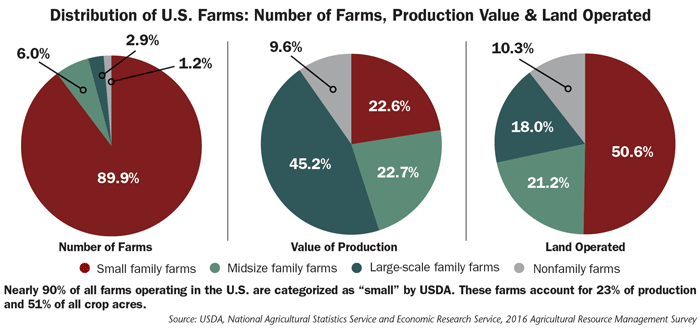From hobby farmers and large property owners to landscape contractors and municipalities, the customer base for rural lifestyle equipment dealers is diverse and segmented. For dealers who specialize in smaller equipment, the professional farmer who is categorized as “small” should also represent a fertile area for customer prospecting — because it’s huge! And often these farmers want to deal with someone they consider “local” and who they can get to know.
USDA defines a farm as any place that produced and sold — or normally would have produced and sold — at least $1,000 of agricultural products during a given year. Farm size is measured by gross cash farm income (GCFI), a measure of the farm’s revenue that includes sales of crops and livestock. A “small” farm is considered as one with a GCFI with less than $350,000 annually.
Here are a few other statistics and classifications of small family farms from the 2016 Agricultural Resource Management Survey that demonstrate their potential for equipment dealers:
- Retirement farms. Small farms whose principal operators report they are retired, although they continue to farm on a small scale (366,812 farms; 17.9% of U.S. farms).
- Off-farm occupation farms. Small farms whose principal operators report a major occupation other than farming (860,739 farms; 41.9% of U.S. farms).
- Farming-occupation farms. Small farms whose principal operators report farming as their major occupation with low sales, or GCFI less than $150,000 (506,001 farms, 24.7% of U.S. farms); with moderate-sales, or GCFI between $150,000 and $349,999 (110,524 farms; 5.4% of U.S. farms).
Most U.S. Farms are ‘Small’
The fact of the matter is most farms fall into the “small” category. At the same time, they are significant contributors to overall farm production. Overall, 90% of U.S. farms are small and these farms accounted for 51% of the land operated and 23% of production in 2016. In addition, small farms produce 59% of U.S. poultry output and 50% of all hay produced.
Editor’s Note: The data presented here was compiled by the Agricultural Resource Management Survey (ARMS), an annual survey conducted by USDA’s National Agricultural Statistics Service and ERS. This information is based on a sample of approximately 18,500 farms. Totals may not add to 100% due to rounding.






Post a comment
Report Abusive Comment